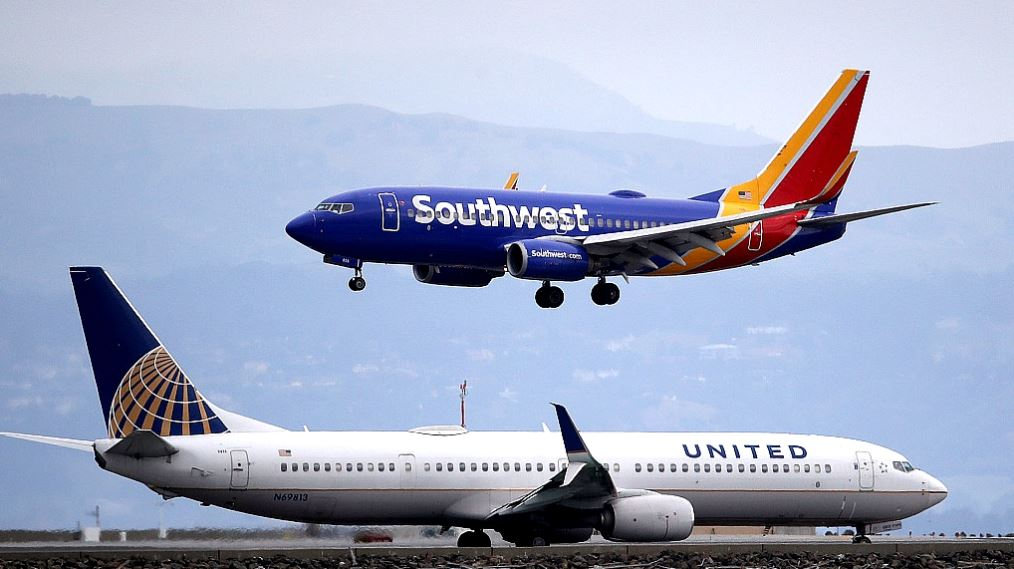
A Southwest Airlines plane lands next to a United Airlines plane at San Francisco International Airport, California, the United States of America, March 6, 2020. /VCG
A Southwest Airlines plane lands next to a United Airlines plane at San Francisco International Airport, California, the United States of America, March 6, 2020. /VCG
Editor's note: Freddie Reidy is a freelance writer based in London. He studied history and history of art at the University of Kent, Canterbury, specializing in Russian history and international politics. The article reflects the author's opinions, and not necessarily the views of CGTN.
On March 12, British Airways CEO, Alex Cruz sent a memo to employees entitled "The Survival of British Airways." Many at that point knew the impact on the airline industry would be substantial but the language seemed verging on hyperbolic. Two months later, Cruz appears vindicated as the picture looks increasingly bleak for airlines.
Virgin Atlantic announced Tuesday that they would be cutting 3,000 from its workforce of 10,000 as well as ending its operations from London's second airport, Gatwick, which primarily serves leisure destinations. The pain felt by Virgin Atlantic is typical of the struggle many airlines are having across the globe. Virgin's sister operation in Australia is seeking 130 million Australian dollars to remain operational.
Governments are cautious to bail out largely privatized airlines and investors are also voting with their feet. Warren Buffet's Berkshire Hathaway sold its entire position in U.S. airlines; American Airlines, Delta, South West and United representing a vacated position in excess of 6 billion U.S. dollars.
In airline engine manufacturing, General Electric announced 10,000 new job cuts earlier in the week and Rolls Royce have announced 8,000. Airbus has also slowed aircraft manufacturing by 35 percent with Boeing halving their output.
For investors, the airline industry has always been a risky one. Airlines are at the mercy of oil prices and dependent on fully laden aircraft serving major hubs. Many airlines derive the majority of their revenue from a very small number of core routes, a decline in traffic on such a route can have a devastating impact on an airline's bottom line.
The OAG is a body which ranks the profitability of various airlines' routes. It calculated that British Airways generated 1 billion U.S. dollars on a single route; Heathrow to JFK from 2018-19. It is therefore vital for such routes to reopen swiftly.

A China Eastern Airlines staffer disinfects the cabin to prevent the spread of COVID-19, February 18, 2020. /VCG
A China Eastern Airlines staffer disinfects the cabin to prevent the spread of COVID-19, February 18, 2020. /VCG
There are some signs that major routes can be restored though. Australia and New Zealand have launched their "bubble" initiative which aims to connect the two largely COVID-19-free countries with the view to adding other "safe" nations in the future.
Qantas' Melbourne-Sydney route is the second most profitable route on OAG's list and such routes will be vital in stimulating a recovery especially if borders will not open for a "long time."
Joanna Bailey, editor of aviation news site Simple Flying, believes that this model is starting to be followed by other regions. France has recently said it will allow in visitors from EU countries, the UK and the Schengen zone without the need for quarantine.
Airline shares had taken a tumble last week when U.S. Treasury Secretary Steve Mnuchin declared that it was "too hard to tell" when international flights would resume with the U.S. and that "the priority is opening up the domestic economy." For airlines based in America, this is good news as the majority of their revenue is domestic, but for other global players seeking links with New York, Atlanta and Los Angeles, it is grave news indeed.
As the risk of COVID-19 infection remains high, there are a great number of uncertainties. It will be of note that the majority of new cases reported in China came from people flying into the country from abroad and nations will wish to learn from this experience.
Temperature checks at airports and other measures could form part of a new pre-flight routine. On board, Korean Airlines announced that its stewards would be wearing full personal protective equipment on all flights in a bid to maintain safety. EasyJet will be leaving the middle seats of its fleet vacant to maintain distancing and other nations have announced similar precautions.
Aside from the logistical and health challenges is the social change. After months of doing business via Microsoft Teams, Zoom and Hangouts, will there be the same level of demand for business travel in the future? Will people cut down on their travel for environmental reasons as the benefits of radically reduced carbon output becomes clear? Warren Buffet had earlier stated that "The airline business… and I hope I'm wrong, has changed in a very major way."
What appears likely is both business and leisure travel will recover slowly, with short-haul travel quickest to recover as regional and domestic routes reopen first. Airlines will have a small benefit from low oil prices with large airlines presently stockpiling. However, nearly all airlines will emerge from the crisis smaller, offering higher fare tickets due to reduced capacity. A desire to travel again will likely provide an initial lift but there is little doubt that airlines are in a battle for survival.
(If you want to contribute and have specific expertise, please contact us at opinions@cgtn.com.)